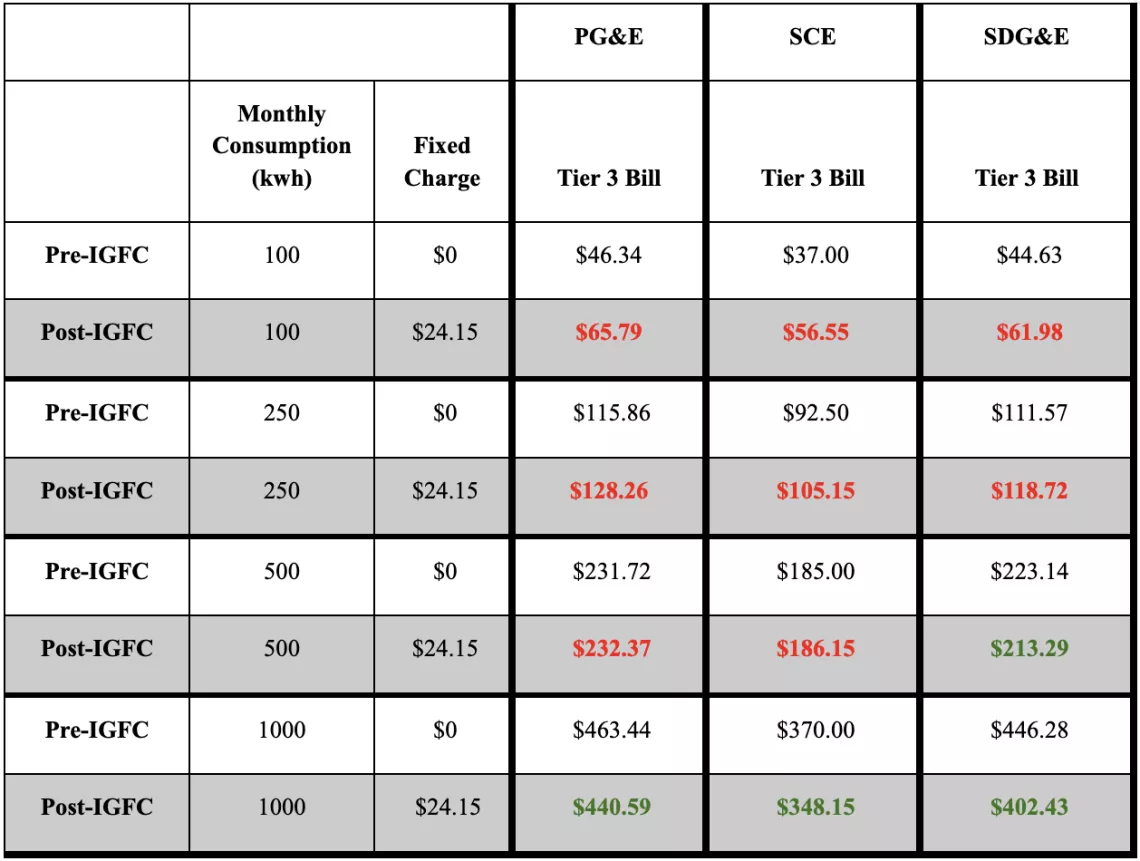Sander Kushen, Sierra Club, sander.kushen@sierraclub.org
SAN FRANCISCO — Today, the California Public Utility Commission (CPUC) voted 4-0 to lower volumetric (per-usage) rates and implement three tiers of monthly electric fixed charges:
- Tier 1 – $6 Fixed Charge – For CARE households, i.e. households earning below 200% of the federal poverty line and those who qualify for certain income-based assistance programs. This tier accounts for approximately a quarter of households.
- Tier 2 – $12.08 Fixed Charge – For FERA households, i.e. households earning between 200 and 250% of the federal poverty line, and those in 80% area median income qualifying affordable housing.
- Everyone Else – $24.15 Fixed Charge
This proposal comes two years after the passage of AB 205, which required regulators to implement income-graduated fixed charges (IGFCs) for Californians’ electric bills.
The IGFCs proposed for investor-owned utilities would create modest bill savings for the low-income customers most burdened by energy bills. The proposed decision would shave approximately 10 - 13 percent off of California’s rising volumetric rates, improving the economics of moving from gas to electric appliances, particularly for CARE customers. However, under this decision some lower-income Californians could see their bills increase. (see Table 1).
The Commission also lumps customers making $50,000 a year into Tier 3 with multi-millionaires, both of which would pay $24 a month in fixed charges. This is likely to raise monthly bills for low energy usage lower-middle class customers while lowering bills for wealthier consumers who tend to use more energy (see Table 2).
The large utilities are charged with implementing fixed charges and volumetric rate reduction by October 2025 (SCE), December 2025 (SDG&E), and March 2026 (PGE).
In response, Sierra Club and the California Environmental Justice Alliance issued the following statements:
Rose Monahan, Attorney for the Sierra Club, said:
“Today’s decision is a modest step towards making equitable electrification a reality—while making rates slightly more progressive and making electrification economics slightly more favorable, it leaves significant affordability and electrification gains on the table by employing a conservative approach. The Proposed Decision smartly rejects some bad proposals—like splitting CARE customers into multiple tiers, levying large fixed charges, and including distribution costs in fixed charges—but it also misses the original intent of AB 205 in crafting a progressive fixed charge structure and guaranteeing bill savings for low-income customers.
“In the next Phase of this proceeding, we continue to call on the Commission to lower Tier 1 and Tier 2 fixed charges to $0, to exempt customers who go all-electric from fixed charges, and to create income tiers for wealthier Californians for a more progressive fixed charge structure. More tiering would allow for greater reductions in volumetric rates to create actual, rather than negligible, impacts on electrification.”
Shana Lazerow, Communities for a Better Environment Legal Co-Director and attorney for the California Environmental Justice Alliance, said:
“California’s environmental justice communities desperately need bill support and rate reform. A true income-graduated fixed charge that brings bill reductions can be an important part of fixing this broken system. Today’s decision delivers a bare minimum first step, nowhere near enough to bring relief to our communities. We know that advancing affordability is one of Governor Newsom’s top priorities, and that’s why it’s so disappointing that his agency isn't going far enough to deliver bill relief for low- and middle-income households. Regulators need to correct course to deliver a progressive proposal that places appropriate fixed charges to high-income Californians, and delivers deeper savings to households that need it.”
Table 1
Low-Income Low-Usage Customer Bill Impacts

Table 2
Tier 3 Customer Bill Impacts

About the Sierra Club
The Sierra Club is America’s largest and most influential grassroots environmental organization, with millions of members and supporters. In addition to protecting every person's right to get outdoors and access the healing power of nature, the Sierra Club works to promote clean energy, safeguard the health of our communities, protect wildlife, and preserve our remaining wild places through grassroots activism, public education, lobbying, and legal action. For more information, visit www.sierraclub.org.